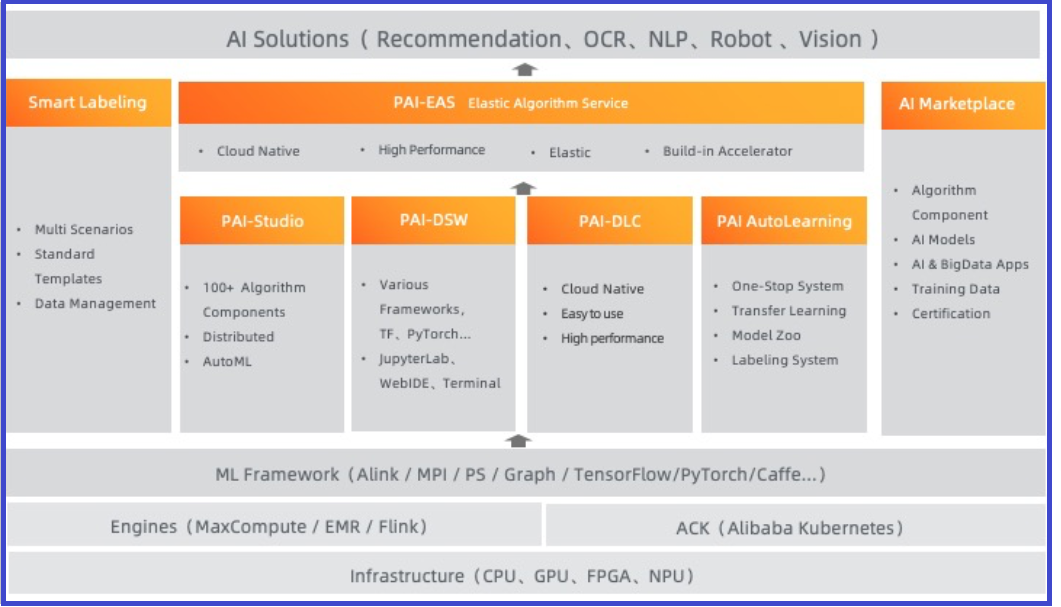By Shantanu Kaushik
In Part 1, we introduced machine learning and the core methodology to achieve optimal results to facilitate learning. This article introduces the Alibaba Cloud Machine Learning Platform for AI (PAI) and the architecture of this solution.
The Machine Learning Platform for AI (PAI) has more usage and implementation scenarios than other available solutions. Let’s use an example of an organization with a strongly defined DevOps pipeline. The DevOps solution is all about automation and reaching the threshold where application delivery is a highly self-sustaining process.
This process includes the following steps:
This application lifecycle is highly regulated with machine learning. Based on different phases, the Machine Learning Platform with AI works with:
Alibaba Cloud Machine Learning uses statistic algorithms to create training models based on huge amounts of historical data. These models are applicable in a number of scenarios and can help make informed business decisions. Alibaba Cloud Machine Learning includes traditional machine learning and deep learning.
Alibaba Cloud Machine Learning Platform for AI was designed to serve enterprises to attain an optimal working cycle and a structure that incorporates the core business values and builds on the historical data. Alibaba Cloud launched the Machine Learning Platform for AI in 2018. Since then, it has worked with thousands of enterprises and individual developers to become one of the leading machine learning and AI solutions available.
Alibaba Cloud Machine Learning Platform for AI supports computing frameworks, such as:
Alibaba Cloud Machine Learning Platform for AI uses multiple layers to distribute workflows:

1. The infrastructure layer includes:
a. CPU and GPU
b. Field Programmable Gate Array (FPGA)
c. Neural Network Processing Unit (NPU) resources
2. The computing engines and container services layer include:
a. MaxCompute
d. Alibaba Cloud Container Service for Kubernetes (ACK)
3. The computing framework layer includes:
a. Alink
b. TensorFlow
c. PyTorch
d. Caffe
e. MapReduce
f. SQL
g. Message Passing Interface (MPI)
4. The presentation layer of the Alibaba Cloud Machine Learning Platform for AI streamlines the workflows of machine learning by:
a. Data Preparation – Smart labeling enables you to label data and manage datasets in multiple scenarios.
b. Model Creation and Training – Machine Learning Platform for AI provides diverse services to meet different modeling requirements, including:
i. Machine Learning Studio provides visualized modeling and distributed training.
ii. Data Science Workshop (DSW) is a notebook-based service for interactive AI research and development.
iii. AutoLearning provides automated modeling.
iv. Elastic Algorithm Service (EAS) can deploy models as online prediction services.
c. Model Deployment – Machine Learning Platform for AI provides models as services:
i. Elastic Algorithm Service (EAS) is a cloud-native online inference platform
ii. Blade is a tool to accelerate model inference.
iii. There is an intelligent marketplace where you can obtain recommended solutions and model algorithms to solve business issues and improve production efficiency.
5. The business layer of Machine Learning Platform for AI is widely used in the following scenarios:
a. Finance
b. Medical Care
c. Academics and Education
d. Transportation
f. Search Systems
g. Recommendation Systems (Decision Engines)
Alibaba Cloud Machine Learning Platform for AI is a highly intuitive solution intended for enterprises and developers. It is a lightweight machine learning platform created using cloud-native technologies.
It provides an end-to-end modeling service that includes the highly efficient Data Science Workshop (DSW). DSW works with interactive modeling, Machine Learning Studio for a no-code visualized modeling experience, Deep Learning Containers (DLC) that makes a superb choice for distributed model training, and Elastic Algorithm Service (EAS) for online prediction.

2,597 posts | 775 followers
FollowAlibaba Clouder - April 28, 2021
Alibaba Clouder - April 16, 2021
Rupal_Click2Cloud - December 12, 2023
Alibaba Clouder - April 23, 2021
Alibaba Cloud Community - December 25, 2024
Alibaba Clouder - April 16, 2021

2,597 posts | 775 followers
Follow E-MapReduce Service
E-MapReduce Service
A Big Data service that uses Apache Hadoop and Spark to process and analyze data
Learn More DevOps Solution
DevOps Solution
Accelerate software development and delivery by integrating DevOps with the cloud
Learn More Alibaba Cloud Flow
Alibaba Cloud Flow
An enterprise-level continuous delivery tool.
Learn More MaxCompute
MaxCompute
Conduct large-scale data warehousing with MaxCompute
Learn MoreMore Posts by Alibaba Clouder
Start building with 50+ products and up to 12 months usage for Elastic Compute Service
Get Started for Free Get Started for Free